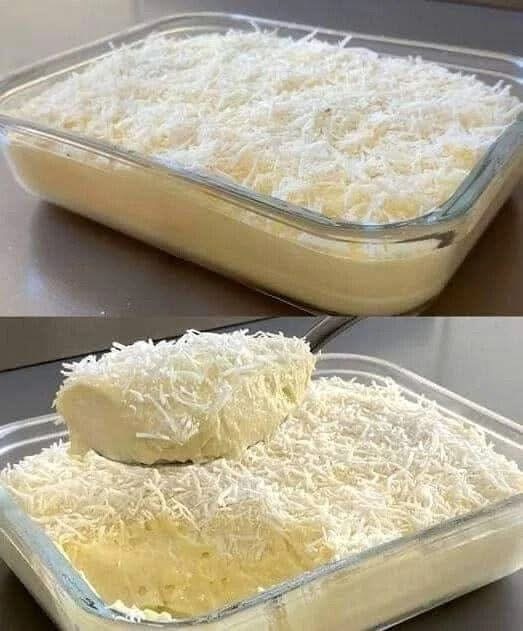No Bake Coconut Pudding

Ingredients:
- 1 liter (4 cups) whole milk
- 1 can (14 oz / 400 g) sweetened condensed milk
- 1 can (12 oz / 300 ml) evaporated milk
- 1 cup (240 ml) heavy cream (or whipped cream)
- 1 cup sugar (adjust to taste)
- 4 tablespoons cornstarch (dissolved in ½ cup cold milk)
- 1 teaspoon vanilla extract
- 1 ½ cups shredded coconut (sweetened or unsweetened, as you prefer)
- Extra shredded coconut for topping
Instructions:
- Prepare the base:
- In a large pot, combine milk, condensed milk, evaporated milk, heavy cream, and sugar.
- Heat over medium heat, stirring constantly.
- Thicken the pudding:
- Once warm, slowly add the dissolved cornstarch mixture while stirring.
- Continue cooking until the mixture thickens into a creamy pudding (about 8–10 minutes).
- Flavoring:
- Stir in vanilla extract.
- Add 1 to 1 ½ cups shredded coconut and mix well.
- Set the dessert:
- Pour the hot mixture into a large glass dish.
- Let it cool to room temperature, then refrigerate for at least 4 hours (or overnight) until firm.
- Finishing touch:
- Before serving, sprinkle the top generously with shredded coconut.
Serving:
- Serve chilled with a spoon straight from the dish.
- Optional: garnish with toasted coconut flakes or white chocolate shavings for extra flavor.
History of Coconut Pudding-Style Desserts
Ancient Roots
- Coconut has been used in desserts for centuries in tropical regions like Southeast Asia, India, the Caribbean, and Africa.
- Early recipes used coconut milk, rice flour, or starch to thicken sweet puddings.
Middle Eastern & Mediterranean Influence
- In the Middle East and Turkey, there are similar milk puddings such as Muhallebi (milk thickened with starch) and Mahalabia, often flavored with rosewater or orange blossom.
- In some countries, shredded coconut was later added when coconuts became more available through trade.
European Touch
- During the colonial era, coconuts were introduced widely to Europe and the Americas.
- In Portugal and Spain, coconut-based custards and puddings appeared in convent kitchens where nuns experimented with milk, sugar, and eggs.
Modern Variations
- In Latin America, it evolved into dishes like Cocada Cremosa (Brazil) and Dulce de Coco (Caribbean).
- In the Philippines, similar desserts exist such as Maja Blanca, made with coconut milk, cornstarch, and sugar, topped with coconut.
- In the West, it’s often made into a chilled, no-bake dessert with condensed milk and whipped cream, like the one in your photo.